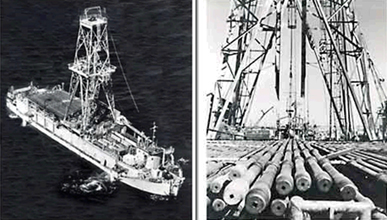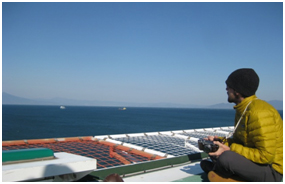

Anniversary of 1st Deep Ocean DrillingApril 2, 2012
Today marked our first full day at sea on this historic ultra-deep ocean drilling and observatory installation expedition. We are all quite excited and prepared to take on the many challenges that will be involved.
Interestingly, today also marked another historic event in the history of scientific ocean drilling and our understanding of the Earth. It was on this day, 51 years ago on April 2nd 1961 that the very first deep ocean drilling expedition collected core samples confirming that the oceanic crust was composed of basalt (a volcanic rock). This was just one of many discoveries at the time that contributed to the development of the theory of plate tectonics.
I was surprised to learn that the shipboard historian on the expedition was none other than the very famous author, John Steinbeck, who later wrote an article about the adventure for LIFE Magazine.

An overhead view of the CUSS 1, the first scientific deep ocean drilling vessel. It was converted from an old Navy barge. While it is small and simple compared to the Chikyu, some the technology developed for it use, including dynamic positioning (using steerable thrusters or propellers to stay in one spot), is still used on the Chikyu today. (US-NSF Photo)
There was even a short documentary made at the time (The First Deep Ocean Drilling Part I, Part II ) about the engineering challenges they faced drilling in water depths of 3500 m that were roughly 30 times deeper than the depths the industry was drilling at the time. They also sought to take core samples that were considerably longer and deeper than commonly collected and to collect subsurface temperature measurements.
The challenges that were overcome with their expedition are in many ways similar to those associated with the JFAST project. We too will be drilling in water depths (7000 m) that are considerably deeper than even deep water commercial drilling. In addition, while two boreholes have previously been drilled at similar water depths, they were only drilled and cored to ~15 m below the seafloor; we plan to go to ~ 1000 m below the seafloor like IODP expeditions in shallower water, collect long sections of core from the fault zone, and also install underground observatories to monitor temperature and pressure.

Patrick (perhaps) contemplating the journey ahead
The JFAST project is going to be difficult, but I, for one, am humbled by the achievements and scientific legacy of this first scientific ocean drilling expedition and those that followed. While we too will be using state-of-the-art technology and even some new technology specifically designed for this expedition, in many ways we will be using many of the same techniques that were used and developed by these early ocean drilling scientists and engineers.

















